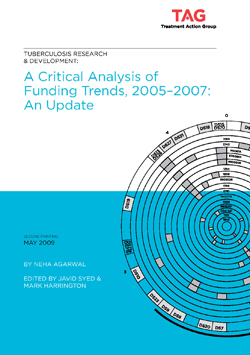Tuberculosis Research & Development: A Critical Analysis of Funding Trends, 2005–2007: An Update
By Neha Agarwal
May 2009 – For the third year, Treatment Action Group (TAG) analyzes and reports on the annual funding of tuberculosis (TB ) research and development (R&D). The top 40 TB research funding institutions were surveyed for actual disbursements made for TB R&D in fiscal years 2005, 2006, and now 2007. The three-year data reveal trends in funding and demonstrates an alarming shortfall in the growth of TB R&D during the initial years covered by The Global Plan to Stop TB: 2006–2015.
In 2007, overall funding for TB R&D increased by $53 million over 2006, a 12.4% increase from $429 million in 2006 to $482 million. In 2006, funding increased by $61 million (16%) from $368 million in 2005 to $429 million. Thus, reported TB R&D investment appears to be increasing in a linear fashion with no evidence of acceleration and the disturbing possibility of deceleration. Given biomedical inflation and the weakened U.S. dollar during this period, a 12.4% annual increase does not reflect meaningful growth. In the first two years covered by The Global Plan, just $537 million was reported spent on research and development of new tools—diagnostics, drugs, and vaccines—for TB, which is just 6% of the $9 billion that The Global Plan recommended be spent on new tools development from 2006–2015.At the current anemic growth rate, achievement of Global Plan R&D targets—let alone the more ambitious TAG recommendation that $20 billion be spent, including basic science, new tools R&D, and operational research—appears most unlikely.
- In 2007, governments remained the largest funders of TB research, contributing 56.5% of the total. Philanthropic institutions contributed 29.2%. The private sector contributed 14.4%. Among the top 13 donors giving $10 million or more per year, the U.S. National Institutes of Health (NIH; all institutes in aggregate) has increased its support for TB R&D by 15% since 2005, while the Bill & Melinda Gates Foundation increased its support by 116%. The European Commission (EC) increased its investment by 75% and Otsuka Pharmaceuticals by 69%. The Netherlands Foreign Ministry, Novartis, the Eli Lilly Foundation, and USAID increased support by 334%, 419%, 9,094%, and 49%, respectively. Four of the major donors have reduced contributions since 2005.
- Of the six categories of research addressed in the analysis, TB drugs continue to receive the highest levels of funding ($170 million), followed by basic science ($121 million) and vaccine research ($71.2 million). Diagnostic research funding remains grossly insufficient at $41.9 million, as does operational research at $36.8 million.
- Investment in new TB diagnostics, drugs, and vaccines increased from $209 million in 2005 to $253 million in 2006 and $284 million in 2007. This falls far short of the Global Plan’s recommendation to spend at least $900 million per year on R&D for new tools for the diagnosis, treatment, and prevention of TB .
- Aside from lack of funding, survey respondents attributed a lack of knowledge surrounding TB pathogenesis and the lack of appropriate biomarkers as the top barriers to accelerating and improving TB R&D. This highlights the importance of increased investment in the basic science of TB biology, immunology, and pathogenesis.
- Overall, 24 institutions increased overall TB R&D spending between 2005 and 2007, while 13 institutions decreased their investment. Five institutions reported in 2007 for the first time.
- Seven institutions that reported on 2005 or 2006 funding did not report for 2007, among them important donors such as the India TB Research Center ($6.3 million in 2006) and France’s INSERM ($5.7 million in 2005). Obtaining data from these institutions as well as others who play a role in TB R&D is essential for maintaining the comprehensiveness and accuracy of these reports and crucial for developing trend analyses. It is kindly requested that these institutions submit TB R&D portfolios as soon as possible.
- Thirty-one institutions have reported data for each of the three years tracked from 2005 to 2007. Of these, 15 showed increased TB R&D investment over the three years while 16 reduced spending. This suggests that TB R&D funders are becoming less diversified and that the field remains dominated by a small number of large funding institutions—not a healthy situation for any scientific field.
The 2007 data shows that TB R&D spending is increasing at a level far too low to achieve Global Plan targets, let alone the more ambitious $2 billion per year from 2006 to 2016 recommended by TAG, which includes the Global Plan’s $9 billion for new tools research plus an additional $11 billion for basic science, infrastructure, and operational research.

